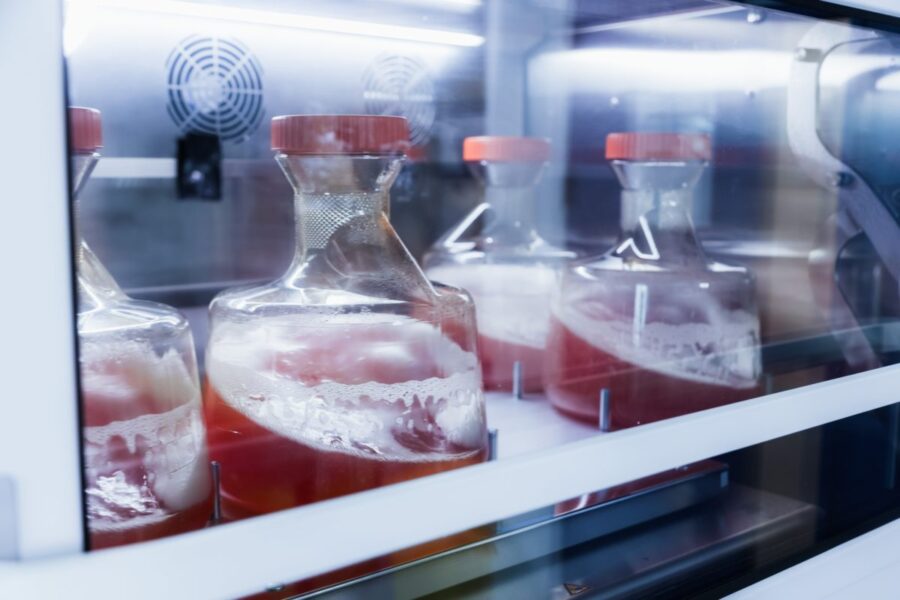Why Abzena?
Trust our focused approach.
Advancements in antibody engineering have paved the way for increasingly sophisticated biologics – including fusions, bispecific antibodies, and bioconjugates – to enter the market.
Although these innovative molecules have helped to improve patient treatment, they are inherently more complex to develop and manufacture. Despite this complexity, the blockbuster status of many biologics has led to sector growth and increasing global demands. The global next-generation antibody market reflects the number of new therapies in progress, with predicted growth from $5.46 billion in 2021 to $12.05 billion in 2028.¹ This rising demand is putting pressure on biopharma to accelerate timelines for IND applications and to deliver vital therapeutics to patients.
In addition, the established accelerated pathway for monoclonal antibodies (mAbs) leads to high expectations regarding biotherapeutic production. However, the increasing complexity of biotherapeutics being brought to market comes with new challenges and requires innovative approaches that take time and experience to design and implement.
To account for these demands, a robust and efficient cell line development (CLD) process, that can adjust for different modalities, is essential. This includes optimization of CLD, upstream development and downstream development to efficiently and reliably produce high-quality medicines. By taking a proactive approach risks can be assessed and potential challenges can be pre-empted, allowing the implementation of mitigating strategies and avoiding costly delays.
Choosing the right lead drug candidate is critical to success. An in-depth understanding of the molecule is crucial, especially as we move towards more complex modalities. In-silico tools allow the evaluation of the primary amino acid sequences to perform sequence risk assessments early in the development process. These assessments identify potential liabilities which may impact the molecule’s safety, function and stability. Anticipating issues that are likely to arise and implementing potential solutions can help minimize timelines, risks and costs. With such knowledge in hand, the molecule can be optimized to engineer out liabilities or, if such changes risk impacting safety or activity, development can continue with strategies to overcome the potential liability. Understanding the potential challenges at the earliest possible point can ensure subsequent activities are designed appropriately, and tight timelines are maintained.
By utilizing the information acquired, an informed choice for a lead candidate can be made. This takes into consideration the scalability, stability, efficacy, and safety of the candidate. The selection made at this stage has a large impact on the remainder of the processes, with molecule characteristics considered during method design to optimize product quality and yield.
CLD is a key step in the development of biotherapeutics, linking R&D and CMC activities. A robust CLD process can be initiated early to allow selection from a panel of potential lead candidates, overlapping CLD with lead optimization. Stable pools can be generated for each candidate and significant amounts of material purified within a matter of weeks. This provides a reading on relative expression levels and downstream development (DSP) yields, indicating platform fit and scalability to compare across candidates.
In-depth analysis of the material produced provides confidence that the platform methods are suitable or, otherwise gives an early heads-up if modifications need to be planned in later development. The purified material may also be assessed for immunogenicity, stability and early formulation and analytical method development. In addition, in-vivo studies can be performed to gauge PK, potency and dose ranges. By utilizing the information acquired, an informed choice for a lead candidate can be made, taking into consideration the scalability, stability, efficacy, and safety.
CLD with the selected lead can continue from the stable pool with fast, single-step cloning using up to date techniques such as micro-fluidics. Taking advantage of high throughput analytics and a good understanding of the candidate’s CQA, rapid clone screening for both productivity and product quality can be performed, taking advantage of high throughput analytics. This allows the project to quickly progress to generate Research Cell Banks (RCBs) and Master Cell Banks (MCBs) which in turn support the production of toxicology batches, cGMP batches and progression to FIH trials.
Efficient communication and collaboration, such as technology transfer, between all groups involved in the development and manufacturing of complex biologics is fundamental to project success. Transparent communication ensures certain development processes can run in parallel, ultimately helping to accelerate timelines for IND applications.
Free-flow access to acquired data helps to define risks early, enabling the introduction of mitigating steps before timelines are affected. The analytical team is vital to identifying these potential risks, determining the feasibility of the desired project aims, and deciding whether the current lead candidate has the potential to meet these aims. Together, the analytical and CLD teams must work to ensure the greatest chance of success with the chosen molecule using this proactive approach.
Optimizing the production of biologics is associated with many challenges, but as shown above, steps can be taken to reach IND through the application of extensive experience and sound judgment of how to optimize timelines.
Having access to expert knowledge and years of experience in the form of a supportive partnership can be invaluable when developing a robust CLD strategy. Customized approaches can be developed and used in combination with reliable, well-defined methods to ensure the best possible outcome for a shortened timeline.
As mentioned, meticulous characterization of the chosen lead candidate is essential. Therefore it is necessary to ensure the chosen development and manufacturing partner has the required capability and is keen to build a strong, free-flowing, and communicative relationship. Partners with these attributes will be well placed to expedite projects and reduce production costs.
Abzena is a bioconjugate- and biologics-focused CDMO+CRO that pushes development of novel treatments forward at every stage from discovery through commercial launch. With over a decade of experience in CLD, the company has expertise in the expression of various biologics including antibodies, antibody fragments, fusion proteins, and vaccines.
Discover how Abzena’s proactive approach to CLD could help to accelerate your next project by downloading our whitepaper entitled: ‘Cell Line Development: The Linchpin in Successful Biotherapeutic Development‘.
